
May 31st (Balos) and June 2nd (Elafonisi) of 2022. The wind! It howls through everything, sending through the air whatever is not nailed down; has people fighting with their towels;
and the palm leaf umbrellas dancing in perfect unison, their whooshing chorus competing with the lapping of the waves.
We are being seared bone dry, body and soul. It’s exhilarating, liberating in a wild way, especially with the tide coming in and warm water sloshing around the metal supports of our loungers. It’s a wind so strong and hot that it blows right through you until there’s nothing left but inertia; we are scoured through and through.
But the day doesn’t begin this way. It begins back in Chania where we get the bus to Elafonisi Beach, famous for its shallow lagoon
and small patches of pink sand formed from minerals and crushed pink shells. Nobody mentions the wind. Or perhaps I just didn’t want to know.
A two hour, 75-kilometre journey, the bus takes us south-west through some of the most dramatic hills and gorges on the island; it’s worth going just for the drive there.
Elafonisi – beautiful soft golden sand surrounding sparkling turquoise lagoons, the sand dunes of Elafonisi Island bisecting the lagoons, and all backed by glorious mountains. We have come to paradise.
But first I want to back track to the bus station in Chania, because I like to tell all the stories. Every country I go to I learn five words: hello, goodbye, please, thank you, and most importantly I’m sorry. From my notes: The previous evening I’d thought to ask J the Greek word to apologize. It’s signomi. In the washroom at the bus station the woman who went into the stall after me started shouting at another woman and pointing at the toilet. I have no idea what she was saying, but I’m guessing that either I’d put the paper in the toilet instead of the bin, and/or I’d forgotten to flush. I had a look in the stall, but couldn’t see anything, and don’t know what she was talking about. Then I spontaneously apologized. Signomi, signomi. She immediately softened, and said something that I thought sounded like That’s alright dear. I learned the hard way that knowing how to apologize in the local language is a small way to be a good ambassador for tourists.
Anyway, back to the beach. We are enchanted. On making our first steps down from the car park we survey our surroundings and talk about what we want to do. We have five hours before the return journey. Fun! A day at the beach. We are happy. At this point all is calm, not even a hint of the wind to come. We rent loungers and lounge in the shade, lulled by the luminous turquoise waters on either side of us.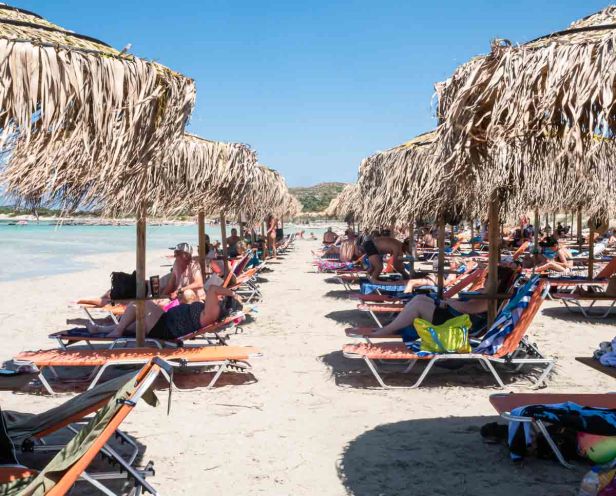
I, of course, want to climb to the top of the hill on the island, which involves wading through the lagoon up to my waist. Don would come with me but he has bandages holding his body together and it’s not a good idea to get them wet. This works out well as he is quite happy to lie in the shade and ogle all the pretty girls in their bikinis.
Although there are a lot of people, the beach area doesn’t feel crowded because it is so huge, however most are concentrated near the lounge beds and snack bar.
The further I walk the fewer people there are, until I am quite alone; alone in the warmth of the day, enveloped by soft sand and blue sky and blue blue water. It all feels like a long mellow hug.
I carefully climb the sand dunes at the beginning of Elafonisi Island.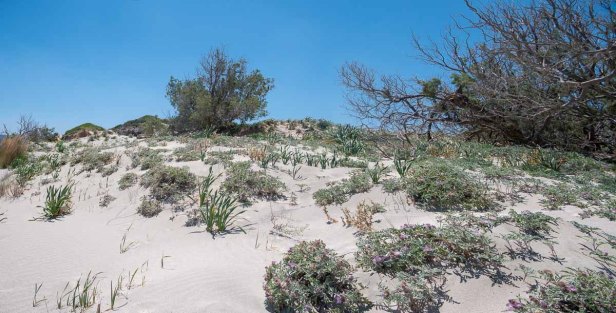
The island, easily reached by foot at lowest tide, or by wading a little when it’s a bit higher, creates a shallow lagoon on one side and a slightly less shallow bay on the other, and I climb high enough to see the whole panorama spread out before me.
Back on the beach I find Don, we buy drinks and snacks, we laze under the shelter of our palm leaf umbrella, watching the people and the wide expanse of welcoming water.
It’s so enticing, as if it’s calling to you to immerse yourself, but Don can’t, and I’m too interested in photographing the people.
There is no better place to take photos of people than at a beach. At the beach we strip down to almost nothing, bare our bodies for the world, and most importantly, lose most of the inhibitions we hold onto in normal life because it’s required of us. No wonder a huge majority of people think the ideal vacation is at a beach. Here we can be free; or at least more free than usual. Here there is room to play. Here we don’t need to be concerned with what anyone thinks about our body; we are all flawed except for the lucky few, and most children. Life is inevitably an aging body, and we’re told it is not something to be welcomed. Ah but at the beach on a hot day no one cares! There’s a sense of relaxation, of exhilaration, of freedom.
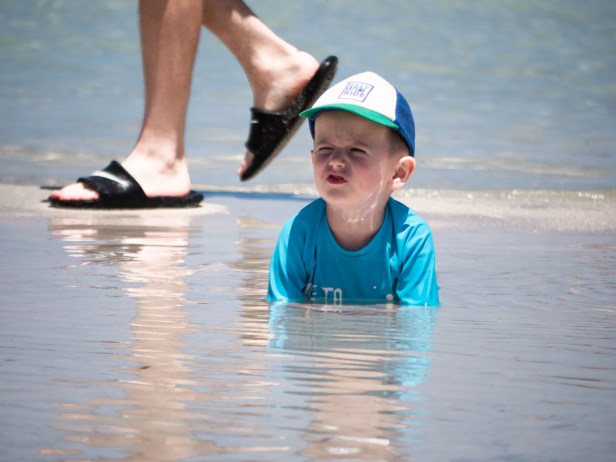








Five hours later, warmed by the sun, scoured and enervated by the wind, and lulled by the lapping water and the beauty of our surroundings, we make our way back up to the car park, collapse into the bus, and all but fall asleep on the journey back to Chania. It’s been a good day.
********************************
Through the bus window, as we travel west from Chania to Kissamos along the north coast of Crete, I see brown dry hillsides striped with olive groves, blue and white churches, and blooming pink and white oleander; and the gorse that grows wild and spreads over the hillsides at this time of the year, in the spring, is an exuberance of dazzling yellow flowers. But best of all, through the bus window in a small village, I find myself looking down into a school yard, and there they are, the children, all lined up, arms across each others’ shoulders, practising the Zorba dance. It’s such a delightful glimpse into the enduring Greek culture. For a brief second or two I feel like more than a tourist.
We are on a city bus, which wends its way through small coastal towns and then into the interior through more small towns, picking up and dropping off passengers along the route. It takes almost an hour and a half to reach Kissamos. From there we take a shuttle bus to the wharf,
and from there a boat, a very large boat that holds over 1000 passengers, though on this day there are only about 400 of us.
There’s plenty of room to hang out in the sun

as we pass the harsh and sere north coast of Crete.
Crete is a more-or-less oblong shape in an east-west orientation, but at the western end of the north coast there are two peninsulas that jut out into the Aegean Sea. And tucked down on the western side of the furthest one is magical Balos Lagoon.
Balos, with good reason, is probably the most photographed beach in Crete; it is no coincidence that Prince Charles and Princess Diana visited Balos in their private yacht many years ago. We’re not that fancy; we come on a very big yacht that’s decidedly not private, but this in no way alters what we see and experience when we get there.
As I walk towards the lagoon I look back at the boat waiting for us,
but soon forget about it as my eyes widen. This whole place is breathtaking; the warm and inviting water; the infinite blues of the Aegean; the surrounding Platiskinos Mountains. Wow! I say to myself. Wow and wow again. This wild natural beauty sings a song of peace and love without even trying.

There’s a narrow sandy isthmus that connects mainland Crete to tiny Cape Tigani. The isthmus divides the area into a warm, shallow lagoon on one side and a relatively sheltered bay on the other. Of course here too I want to climb up for the wide view.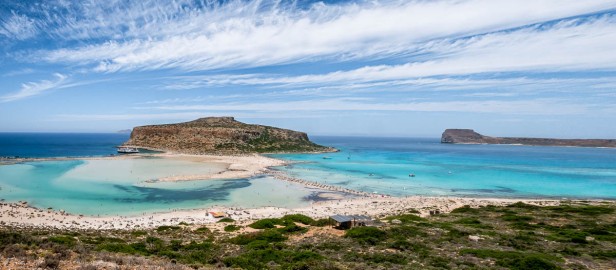
And then I walk along the beach and over to Tigani and climb up there a way as well. There’s a tiny church part way up.
While Don is resting his sorry content ass on the boat, I am once again fascinated with all the people being their wonderful selves, from this group of well-covered ladies having a excellent time,

to the youthful bikini brigade parading in the lagoon,
and everything in between.
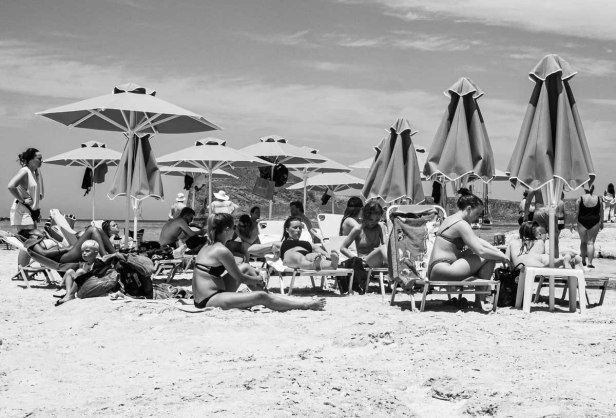
After nearly three hours we return to the boat for the journey to Imeri Gramvousa, a large uninhabited island north of Balos Lagoon. But look up, there’s a fortress at the top of it, a 16th century Venetian Castle, and one of the last forts to succumb to the Ottoman invaders in the 1800’s.
Of course we climb the steep trail and many steps to the top,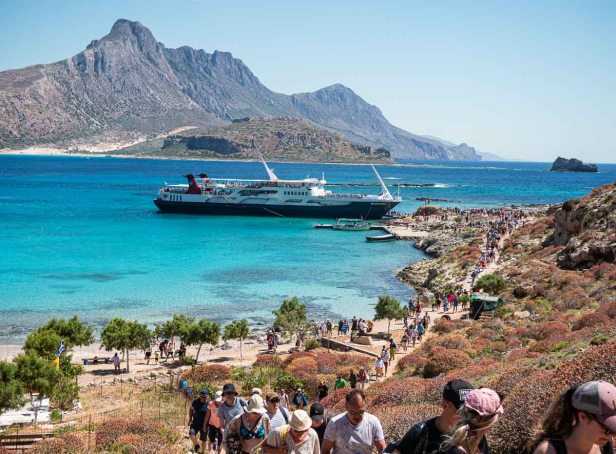
where there’s a substantial entrance gate,
a tiny crumbling church,


some enduring fortress walls,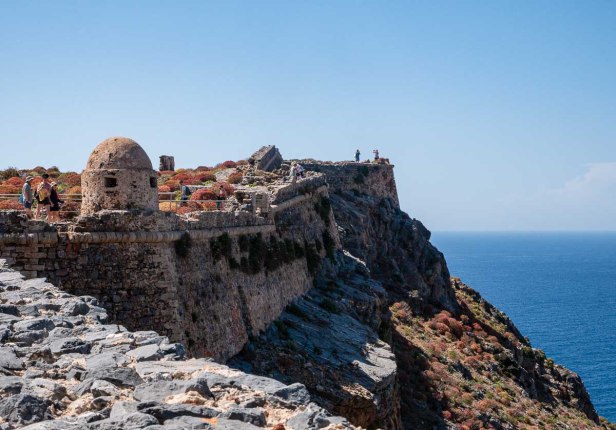
and a fabulous view back towards Cape Tigani and the Platiskinos Mountains.
Ah, we are weary now, resting on the boat ride back to Kissamos, and then falling into the bus for the journey back to Chania. It’s been a day; a long sun-soaked, joy-filled day.
Next post: Canberra Coffee Culture! Well Australian coffee culture with an emphasis on Canberra. Melbourne is undoubtedly the coffee capital of the country, but Canberra holds its own.
Balos: Avoid going in July/August. I’d so glad we went in the spring when the crowds are manageable. It’s hard to get to, which is good because this means there are no hotel developments, or even snack bars. From Kissamos – by boat, with a tour like we did, or ferry; or by driving over a narrow difficult road that’s unpaved towards the end and then hiking down the trail from the car park at the top – I went part way up this trail to get the panorama shot. Whatever way you get there it’s worth it.
Disclaimer: As a general rule, if a photographer is shooting in a public space, such as a street or a park, s/he will usually have the right to do so without the consent of the subjects. Generally speaking if it is in the public domain, you can take a picture of it. Photojournalism and street photography would not exist if permission to take the photo was required. If anyone objects of course I don’t take the photo, or if it’s already done I have them witness me deleting it. In some countries, eg India, people love to have their photo taken, and frequently request it. I always try to be discreet. Quite frequently it creates lovely interactions between myself and the subject. I have found it to be an overwhelmingly positive experience.
All words and images by Alison Louise Armstrong unless otherwise noted © Alison Louise Armstrong and Adventures in Wonderland – a pilgrimage of the heart, 2010-2023.

These are great shots Alison. I think I see my twin grandson’s dopplegangers in some of these photos. Did you eat the baked goat cheese? Some traveling food is so good I fantasize about eating it again.
LikeLiked by 2 people
Thanks so much Cindy. I didn’t eat baked goat’s cheese😳 It sounds so good. Overall we loved Greek food. Whenever I’m served a Greek salad in Vancouver I fantasize about the ones we ate in Greece.
Alison
LikeLike
this looks like an amazing place to visit! I recently booked a trip for myself to visit Costa Rica with a group this summer. I don’t know much about c.r. but am looking forward to the adventure
LikeLiked by 2 people
Both beaches are really amazing. Definitely worth going to.
I don’t know much about CR either but I’ve heard good things and I’d love to go. Have a great trip!
Alison
LikeLiked by 1 person
thanks!
LikeLiked by 1 person
Beautiful pics. Thanks for the tips about learning to say I’m sorry. I usually learn multiple phrases but I’ve never thought of that.
LikeLiked by 1 person
Thanks so much Peggy. I never learn phrases, mostly because I think I’ll never remember them, or the right opportunity to use them won’t materialize. I’m sorry has come in handy several times. Maybe if I learn phrases the opportunities to use them them will arise. But then I’d have to be able to understand the answer 😂
Alison
LikeLiked by 1 person
wow
LikeLiked by 1 person
Yeah, I agree. Both places amazingly beautiful.
Alison
LikeLike
We were in Crete (and several other islands) a number of years ago and absolutely loved it. I am so impressed that you are still out there traveling — I miss that lifestyle so much. We are happily settled in Novato in Marin County, California. But who knows — perhaps we will run into you somewhere out there again!!!
LikeLiked by 1 person
Lily! How fabulous to hear from you! We loved Crete too. We loved *Greece*! I hope we’ll get back there one day.
We also are settled – in Vancouver. We travel usually about 2 to 3 months a year. It would be so fun to run into you again!
Alison
LikeLike
Sand dunes by the shore to ruins…sounds like my perfect day.
LikeLiked by 1 person
They were definitely perfect days. We’re not really “beach people” but the setting at both places was so spectacular that it was impossible to be disappointed.
Alison
LikeLiked by 1 person
So many beautiful scenes, but I think Balos Lagoon intrigues me the most especially your picture looking toward Cape Tigani. All of this and then you find a fortress in the perfect cliff top location! Maggie
LikeLiked by 1 person
Aren’t they beautiful places. I’m so glad we went to both, and the ruins were a definite bonus!
Alison
LikeLiked by 1 person
Some fabulous beach photos. I especially love the ones featuring children. Thnks for taking us with you to the beach.
LikeLiked by 1 person
Thanks so much Darlene, my pleasure. Kids at the beach are an endless delight – so uninhibited!
Alison
LikeLiked by 1 person
Wow, the color of the water is just so beautiful!
LikeLiked by 1 person
Isn’t it though! So beautiful and alluring.
Alison
LikeLiked by 1 person
Crete is so different from the other islands. Great post. Hope to return one day.
LikeLiked by 1 person
Thanks so much Susan. I too would like to return to Crete. Fasinating place, and we definitely only scratched the surface. Much more to discover there I’m sure.
Alison
LikeLike
Alison, I never thought of learning how to say sorry in the local language when I travel abroad, but now I realize that’s something I should do in the future. There seems to be beauty everywhere you looked and went on this island, Alison. When you were wowed by Balos, I know I will be wowed too because you have high standards for beaches. A boat ride to Imeri Gramvousa sounds very appealing to me as well because of that fortress. Crete seems to live up to its reputation.
LikeLiked by 1 person
Everywhere we went on Crete was beautiful, but especially the beaches; well everywhere we went in Greece really. And we went to three fortresses – those Venetians sure knew how to build.
I don’t know what got me started on “I’m sorry”. But I sure remember one time I’d forgotten learn it and really needed it, and other times it really came in handy.
Alison
LikeLiked by 1 person
what a post! the many “people shots” really gave us a feel for diversity in age and life enjoyment and such wonderful beach/water
🙂
LikeLiked by 1 person
Thanks so much Yvette, I’m glad you liked it. Both days were pretty spectacular. I think street photography is my favourite. People are endlessly fascinating and amazing to me. I have trouble finding a home for all my photos and think I may start a photography blog – it would be mainly for people pics.
Alison
LikeLiked by 1 person
Hi – the blog sounds like a good idea to showcase the street shots you capture
LikeLiked by 1 person
I got a notification for this post as I was out on a ride, and stopped (at some roadworks) to check it out. Not only I loved the feeling of warmth and clean water on what has been a rather cold and muddy morning (hey London it’s April 9th!) but I had a massive hankering for some gyros with halloumi. Which I obviously couldn’t have as it was Easter Sunday, early morning and everything’s shut!
LikeLiked by 1 person
So glad I gave you a feeling of warmth on a dreary London morning (it’s currently the same here in Vancouver) and sorry I can’t offer gyros with halloumi. Thanks for stopping to take a look while you’re out on a ride!
Alison
LikeLiked by 1 person
You guys must have been exhausted. That was a long day, Alison. My favorite photo was the view back towards Cape Tigani and the Platiskinos Mountains. –Curt
LikeLiked by 1 person
It was two separate days Curt! I guess I didn’t really make that clear.
So many beautiful views in that part of the world, though you picked one of my faves too.
Alison
LikeLike
I.e. Two long days. Grin.
LikeLiked by 1 person
Everything about the abandoned island intrigues me, but that small crumbling church hit me in a place the rest of the pics did not.
Your comments about the wind remind me of the time we stopped in North Carolina’s Outer Banks as a child. We were on our first (of two, it turned out) family vacations: a road trip from Wisconsin to the East Coast. When my brother (age 6) and I (age 9) heard “we’re stopping at a beach” we were ECSTATIC. No one mentioned the wind! Little bits of sand and grit constantly blowing in your eyes, your mouth, your face, on your hands. It was not quite the hit my parents were expecting.
LikeLiked by 1 person
Oh you liked the small church! I love that. I was so drawn to it when we were up there and just had to go inside.
Your poor parents – taking you two to a windy beach. It must have been so disappointing for all of you. I do hope you’ve had better beach experiences since!
Alison
LikeLike
I love small churches in “abandoned in the modern age” out of the way locations. Modern churches have no appeal, but give me church ruins and I’m there. 😉
To be fair to my parents, I don’t think they knew about the wind beforehand, and I expect they were as miserable (or more) than we were.
Happily yes, I’ve had lovely beach experiences since! Though I have not been back to the Outer Banks.
LikeLiked by 1 person
What gorgeous photos of sand and sea! They entice me to try beach-going again, something we tend to leave out of our travels because we are too fixated on movement and action “while we are young,” according to my husband. I used to love the shore, and still do, and I think I will declare it’s time to occasionally enjoy it again sometime soon.
LikeLiked by 1 person
Thanks so much Lexie. We don’t usually have beaches that high on the list, but in Greece what’s a person to do?! We rarely swim, but always go for walks along them, and have discovered the lazy joy of a beach with lounge beds and shade umbrellas.
Alison
LikeLiked by 1 person
Your description of the hot winds at the beginning set the stage for this post ~ you have a certain magical charm when writing about your travels… and I have wanted to go to Crete 🙂 There is this relaxing joy that fills this post, and the photos you share add to your story. My favorite is the one of Don resting comfortably on the ferry near the end of this post; it is the same seat I would take to sit back and enjoy the moment.
LikeLiked by 1 person
Thank you so much Dalo, I appreciate your encouragement. Writing is both a challenge and a joy for me – keeps me on my toes! I’m glad you got the feeling of relaxing joy. We loved both places, and I definitely recommend Crete as a destination. It has much to offer. I have posts coming up about Iraklio and Knossos.
Alison
LikeLike
Most of the beach photos are serene and calming – you wouldn’t know about the wind. But I love your descriptions of the wind best.
LikeLiked by 1 person
Thanks so much Ruth. We did have a few hours at Elafonisi before the wind came. Then we got scoured!
Both beaches are really beautiful. Stunning really, their beauty not diminished at all by the biggish groups of people. (Not sure though that I’d want to be in either place in July or Aug.)
Alison
LikeLiked by 1 person
We enjoyed Crete… about 35 yrs. ago. Did not go to a beach. We went to other beaches in Santorini and elsewhere. I’m not really a beach person since I bike alot, can’t swim, etc. When we biked in Hawai’i I just wanted to rest under palm trees after a ride.
I also have a warning from dermatologist to put on a ton of sunblock and cover my skin.
LikeLiked by 1 person
We’re not really beach people either, though a day on a lounger in the shade with easy access to shallow calm warm water, and snacks and drinks, can be pretty soothing. We went mainly for the incredible scenery. Both places very beautiful.
Alison
LikeLiked by 1 person